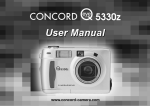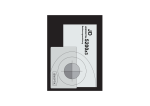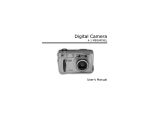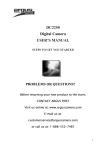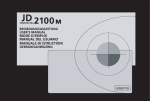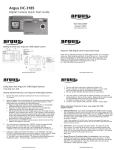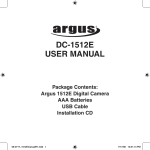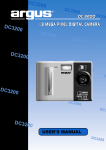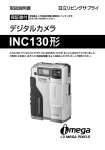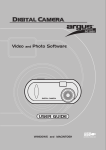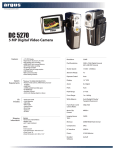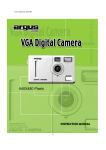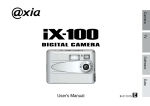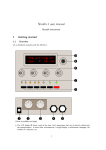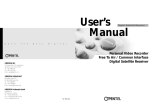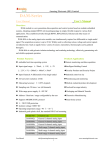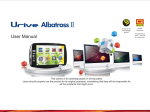Download Argus Camera DC3810 Digital Camera User Manual
Transcript
DC3810 USER'S MANUAL ***STOP!*** Problems or Questions? Before returning your new product to the store, CONTACT ARGUS FIRST; Visit us online at: www.aguscamera.com E-mail us at: [email protected] or, call us at: 1.888.552.7487 ACCESSORY POWER OPTION: AC Adapter 6V 1A (sold seperately) pg. 28 SYSTEM REQUIREMETS WINDOWS • Windows® 98; 98 SE; Windows 2000 prof.; Windows Me; Windows XP • 32 MB RAM • 110 MB free memory capacity • VGA color monitor • CD ROM drive • USB PORT SYSTEM REQUIREMETS MACINTOSH ® IMac; iBook; G3 blue & white series; G4 series • Mac OS 9.0; 10.1.3 • 64 MB RAM or higher • 110 MB free memory capacity • VGA color monitor • CD ROM drive • USB PORT Thank you for purchasing the Argus DC3810. Please read through this instruction manual so you can enjoy all its features. The CE mark on your camera certifies that the DC3810 meets the requirements of EU (European Union) regulations concerning interference-causing equipment. CE stands for Conformité Européenne (European Conformity). Digital Camera DC3810 Tested To Comply With FCC Standards FOR HOME OR OFFICE USE This device complies with Part 15 of the FCC Rules. Operation is subject to the following two conditions: (1) This device may cause interference. (2) This device must accept any interference received, including interference that may cause undesired operation. This Class B digital apparatus complies with Canadian ICES-003. Do not remove the ferrite cores from the cables. 3 FOR PROPER AND SAFE USE Read and understand all warnings and cautions before using this product. This is a descriptive statement warning of the result if the instructions are ignored or not understood. WARNING Batteries may overheat due to improper use. • Use 4 each AA alkaline or 4 each AA Ni-MH batteries. • Do not mix batteries of different types, brands, ages, or charge levels. • Do not subject batteries to fire or high temperatures. • Do not attempt to recharge, short, or disassemble batteries. • Do not install batteries with polarities (+/-) reversed. • Follow local regulations for battery disposal. • Keep batteries and other small objects away from small children. Contact a physician immediately if an object is swallowed. Immediately remove the batteries and discontinue use if: • If the camera's internal components become exposed for any reason, remove all power sources . • Do not walk while viewing monitor. • Properly dispose of batteries that show wear or damaged. • Do not expose batteries to water or moisture. • Do not store batteries on metallic surfaces. 4 WARNING • Never recharge alkaline batteries! • Properly dispose of leaking batteries. Incase of accidental contact with eyes, immediately flush with plenty of fresh water. Seek medical attention. If battery fluid contacts skin and/or clothing, wash area thoroughly with soap and water. • Use only an Argus-specified AC adapter. Improper voltage may result in permanent damage to your camera. (Argus specifies 6V 1A--sold separately) • Do not drop, crush, or immerse camera in liquid; electrical shock may result. • Do not expose eyes to direct flash. • Do not use camera near flammable liquid or gas; explosion or fire may result. • Do not clean camera with flammable products; explosion or fire may result. • Immediately disconnect power source (batteries, AC adapter) if camera smells hot or emits smoke. (Use caution when disconnecting power source; camera may be hot.) • Do not disassemble camera; electric shock may result. Refer to arguscamera.com for warranty and repair information. 5 CAUTION Camera temperature rises with extended periods of use. Use caution when handling. • Do not expose camera to extremely high temperatures. Leaving camera inside a sealed vehicle under direct sunlight or any prolonged exposure to direct sunlight may adversely affect the camera's internal components. • Remove all power sources when storing camera for prolonged periods. • Store camera in a cool, dry, dust-free environment. 6 BEFORE YOU BEGIN Check the parts list before you begin. If some parts are missing, contact your camera dealer or refer to arguscamera.com for warranty and repair information. • ARGUS DC3810 ZOOM camera........(x 1) • AA-size Alkaline Batteries................(x 4) • Video Cable.......................................(x 1) • Hand Strap........................................(x 1) • Camera Case.....................................(x 1) • USB Cable.........................................(x 1) • 32 MB CompactFlash Card...............(x 1) • Software and Documentation on CD-ROM: USB Driver Software for Windows® 98; Windows 98 SE; Windows 2000; Windows XP and Mac® OS 9.0; 10.1.3 Instruction Manual (PDF) Windows and Macintosh PhotoImpression; VideoImpression • Documentation (Printed) Warranty Card (x 1) 7 TABLE OF CONTENTS FOR PROPER AND SAFE USE . . . . . . . . . . .4 BEFORE YOU BEGIN . . . . . . . . . . . . . . . . . . .7 TABLE OF CONTENTS . . . . . . . . . . . . . . . . . .8 NAMES OF PARTS . . . . . . . . . . . . . . . . . . . .12 CAMERA BODY . . . . . . . . . . . . . . . . . . . .12 INSIDE THE TERMINAL COVER . . . . . .14 BOTTOM OF BODY . . . . . . . . . . . . . . . . .14 DATA PANEL . . . . . . . . . . . . . . . . . . . . . .15 VIEWFINDER . . . . . . . . . . . . . . . . . . . . . .16 AUTO POWER OFF . . . . . . . . . . . . . . . . . .28 USING THE AC ADAPTER (6V 1A) (sold separately) . . . . . . . . . . . . . . . . . . . . 28 INSERTING/REMOVING THE COMPACT FLASH (CF) CARD . . . . . . . . . . . . . . . . . . . . .29 INSERTING THE CF CARD . . . . . . . . . . .29 REMOVING THE CF CARD . . . . . . . . . . .30 QUICK REFERENCES . . . . . . . . . . . . . . . . .18 GETTING STARTED . . . . . . . . . . . . . . . . . . .18 TAKING PICTURES . . . . . . . . . . . . . . . . . . . .18 MONITORING THE CAPTURED IMAGES . .20 DELETING IMAGES . . . . . . . . . . . . . . . . . . .21 TAKING PICTURES BASIC RECORDING PROCEDURE. . . . . . . . .33 THE RECORDING MODE DISPLAY ON THE LCD MONITOR . . . . . . . . . . . . . . . . . . . . . . . .35 THE DISPLAY OF THE CAMERA SETTINGS .36 ADJUSTING THE FOCUS . . . . . . . . . . . . . . . .37 FOCUS LAMP . . . . . . . . . . . . . . . . . . . . . . .37 PREPARATION ATTACHING THE HAND STRAP . . . . . . . . . .24 INSERTING THE BATTERIES . . . . . . . . . . . .25 CHECKING THE BATTERY POWER . . .27 FOCUS DISTANCE IN THE AUTOFOCUS MODE (Minimum Focus Distance)....................37 THE SUBJECT THAT IS DIFFICULT TO FOCUS 8 IN THE AUTOFOCUS MODE . . . . . . . . . . . . .38 WHEN THE SUBJECT IS NOT IN THE CENTER OF THE FRAME (Focus Lock Function) . . . . . . . . . . . . . . . . .39 ADJUSTING THE FOCUS DISTANCE . . . .40 CLOSE UP . . . . . . . . . . . . . . . . . . . . . . . . .41 ADJUSTING THE FOCUS AREA . . . . . . . .43 FLASH . . . . . . . . . . . . . . . . . . . . . . . . . . . . . . .44 FLASH RANGE . . . . . . . . . . . . . . . . . . . . .44 SELECTING THE FLASH MODE . . . . . . .45 FLASH LAMP . . . . . . . . . . . . . . . . . . . . . ..46 ADVANCED OPERATIONS P/A/S/M EXPOSURE EXPOSURE MODES . . . . . . . . . . . . . . .48 DIGITAL ZOOM . . . . . . . . . . . . . . . . . . . . . . . .50 BURST IMAGE CAPTURE . . . . . . . . . . . . . . .52 SELF-TIMER . . . . . . . . . . . . . . . . . . . . . . . . . .54 ISO SETTING . . . . . . . . . . . . . . . . . . . . . . . . .56 EXPOSURE COMPENSATION . . . . . . . . . . ..57 MOVIE CLIP SHOT . . . . . . . . . . . . . . . . . . . . . .59 MOVIE CLIP PLAYBACK . . . . . . . . . . . . .60 MOVIE CLIP SETTING . . . . . . . . . . . . . . .60 VOICE RECORDING . . . . . . . . . . . . . . . . . . .61 VOICE PLAYBACK . . . . . . . . . . . . . . . . .62 SPECIFYING THE RECORDING MODE SPECIFYING THE RECORDING MODE . . . .64 THE RECORDING MODE MENU DISPLAY (LCD Monitor) . . . . . . . . . . . . . . . . . . . . .64 RECORDING MODE MENU ITEMS . . . .64 SPECIFYING IMAGE QUALITY MODE . . . . .68 SPECIFYING THE IMAGE SIZE MODE . . . .71 SPECIFYING WHITE BALANCE MODE . . . .73 SPECIFYING THE SHARPNESS MODE . . .75 RESETING TO THE RECORDING MODE DEFAULT SETTINGS . . . . . . . . . . . . . . . . . . . . . . . . . . . .77 9 PLAYBACK MODE SINGLE-FRAME PLAY . . . . . . . . . . . . . . . . . . 80 THE PLAYBACK MODE DISPLAY ON THE LCD MONITOR . . . . . . . . . . . . . . . . . . . . .81 THE IMAGE INFORMATION DISPLAY IN THE PLAYBACKMODE . . . . . . . . . . . . .82 INDEX PLAY . . . . . . . . . . . . . . . . . . . . . . . . . . 83 ZOOM PLAY . . . . . . . . . . . . . . . . . . . . . . . . . . 85 SLIDE SHOW TO START THE SLIDE SHOW . . . . . . . . .87 TO STOP THE SLIDE SHOW . . . . . . . . . .88 THE SETTING IN THE SLIDE SHOW MODE MENU . . . . . . . . . . . . . . . . . . . . . .89 DELETING IMAGES DELETING SELECTED IMAGE . . . . . . . . . . .92 DELETING ALL IMAGES. . . . . . . . . . . . . . . . .95 DELETING FOLDERS . . . . . . . . . . . . . . . . . .97 ADJUSTING THE BRIGHTNESS OF THE LCD MONITOR . . . . . . . . . . . . . . . . . . . . . . . . . . . . .99 10 SPECIFYING THE PLAYBACK MODE THE PLAYBACK MODE MENU . . . . . . . . . .101 THE PLAYBACK MODE MENU (LCD Monitor) . . . . . . . . . . . . . . . . . . . . . . .101 THE PLAYBACK MODE MENU ITEMS AND EACH SETTINGS . . . . . . . . . . . . . . . . . . . .101 SPECIFYING THE PRINT SETTINGS WITH THE DPOF . . . . . . . . . . . . . . . . . . . . . . . . . .103 SPECIFYING THE IMAGE AND THE NUMBER TO BE PRINTED . . . . . . . . . .104 SPECIFYING THE INDEX PRINT SETTINGS . . . . . . . . . . . . . . . . . . . . . . .106 TO CANCEL THE PRINT SETTINGS WITH THE DPOF . . . . . . . . . . . . . . . . . . . . . . .108 FOLDER NAME . . . . . . . . . . . . . . . . . . . . . .109 SELECTING A FOLDER .. . . . . . . . . . . . .110 GIVE FOLDER A NEW NAME . . . . . . . . .111 On DCF (Design rule for Camera File system) Format . . . . . . . . . . . . . . . . . . . . . . . . . . . . .113 SETUP THE SETUP MODE MENU DISPLAY . . . . . .115 THE SETUP MODE MENU DISPLAY ON THE LCD MONITOR . . . . . . . . . . . . . . . . .115 THE SETUP MODE MENU ITEMS AND EACH SETTINGS . . . . . . . . . . . . . . . . . . .115 SPECIFYING THE TIME FOR THE AUTO POWER OFF FUNCTION . . . . . . . . . . . . . . .117 FORMATTING THE CF CARD . . . . . . . . . .119 SETTING THE DATE / TIME . . . . . . . . . . . .121 SETTING THE BEEP SOUND . . . . . . . . . . .123 SWITCHING THE VIDEO SIGNAL FROM THE VIDEO OUTPUT TERMINAL . . . . . . . .125 SWITCHING THE LANGUAGE DISPLAYED ON THE LCD MONITOR . . . . . . . . . . . . . . . .127 RESETTING TO THE DEFAULT SETTINGS. 128 CONNECTING TO YOUR PERSONAL COMPUTER CONNECT TO PERSONAL COMPUTER For Windows® 98 . . . . . . . . . . . . . . . . . .131 For Macintosh®. . . . . . . . . . . . . . . . . . . . 141 CAUTIONS WHEN CONNECTING TO THE PERSONAL COMPUTER . . . . . . .146 INSTALLING Photo Impression & Video Impression . . . . . . . . . . . . . . . . . . . . . 135&141 APPENDIX WATCHING THE CAPTURED IMAGES ON TV . . . . . . . . . . . . . . . . . . . . . . . . . . . . . 150 TROUBLESHOOTING . . . . . . . . . . . . . . . . 151 NOTES ON THE HANDLING . . . . . . . . . . .155 CARE AND STORAGE . . . . . . . . . . . . . . . .159 TECHNICAL DETAILS. . . . . . . . . . . . . . . . 160 11 NAMES OF PARTS CAMERA BODY * Do not touch lens with fingers. 12 CAMERA BODY AF 13 INSIDE THE TERMINAL COVER USB connector Video-out terminal BOTTOM OF BODY Batt. compartment door Tripod socket 14 AC Adapter input DATA PANEL The following diagram shows features displayed. Image-size indicators Flash-mode indicators Battery-condition indicator Self-timer indicator Numeric display of recordable remaning frame No-card indicator * Refer to the number of recordable remaining frames as a guide. The number changes depends upon the scene or subject being recorded. 15 VIEWFINDER Focus Iamp (green) Close-framing guide Flash Iamp (red) Close-framing guide When using the viewfinder to shoot a subject closer than 1m, the area under the close-framing guide will be recorded. Use the LCD monitor to check image composition. 16 Focus Lamp (Green) Illuminated Blinks quickly. (about eight per second) The focus is determined and locked. The focus is not determined. (The subject contrast is too low, the subject is too dark or too close, or the subject is too far in the close-up mode.) Blinks slowly. (about two per second) The image is busy recording onto the CF (Compact Flash) card. The camera reads out the image from the CF card. Focus Area (as a Guide) In the autofocus mode, the focus is adjusted in the gray area as shown. Flash Lamp (Red) Illuminated Blinks quickly when the shutter-release button is pressed completely down. (about eight per second) After canceling flash function, light blinks slowly. (about 2 per second) Flash is charged and ready to fire. The flash is charging. Shutter speed is very slow. Pictures taken in this mode will blur with any movement of camera. Tripod recommended. 17 QUICK REFERENCES GETTING STARTED 1 Insert the batteries (see page 25). 2 Insert the CF card (see page 29). Caution: We suggest using Sandisk or Hitachi CF card. TAKING PICTURES – See page 33 for details. 1 Rotate function dial to . 2 Slide power switch to run on camera. • Press the display button 18 to view LCD monitor. 3 Determine the image composition while looking into LCD monitor or viewfinder. 4 Zoom in or out. ( / ). • To zoom in, press the • To zoom out, press the button. button. 5 Hold the shutter-release button halfway down to focus. 6 Press the shutter-release button full-way down to take the picture. • The LCD monitor will display the captured image. • The green focus lamp will blink slowly while the camera loads the image to the CF card. 19 MONITORING THE CAPTURED IMAGES – See page 82 for details. 1 Rotate the function dial to . 2 Slide the power switch to turn on the camera. • The LCD monitor will display the last recorded image. 3 Pressing the or key will scan through the previous or next images in sequence. 20 DELETING IMAGES – See page 92 for details. 1 Display the image to be deleted on the LCD monitor by performing from steps 1 and 2 of "MONITORING THE CAPTURED IMAGES" described on the previous page. 2 Press the MENU button then press . • The playback mode menu will appear on the LCD monitor. 3 Arrow up or down to highlight (SELECT IMAGE). 4 Select the image to be deleted. • Arrow to photo to be deleted and press . Arrow to next picture to be deleted and again press . When you finish selecting the photos to be deleted, press ENTER. 21 • On the "Delete selected image" page, arrow up to highlight "No" and down to highlight "Yes". 5 Press the the key. key so that [YES] is highlighted and press • The selected images will be deleted. 6 Press the MENU button to quit. 22 PREPARATION 23 ATTACHING THE HAND STRAP 1 Insert the smaller loop of the hand strap through the strap eyelet. 2 Insert the other end of the hand strap through the small loop. 24 INSERTING THE BATTERIES This camera uses four AA-size alkaline or Ni-MH batteries. (Do not mix batteries of different types.) * When using AA-size Ni-MH batteries, fully recharge them with a vendor-endorsed battery charger. 1 When replacing the batteries, slide the power switch to turn off the camera. 2 Slide the battery-chamber door slightly in the 1 direction and open it in the 2 direction. 3 Install the batteries. Be careful to follow the +/- diagram indicated on front of the battery-compartment. 25 4 Close the battery-chamber door in the direction of the arrow 1 and slide it until it clicks 2 . • After replacing the batteries, check that the built-in clock (date and time) works correctly (See page 121). If the camera has no power source for approximately five minutes, the built-in clock may delay or reset to the default setting. In this case, set the date and time again by following the procedure described on page 121. • To avoid damaging the battery compartment door, make sure it is completely shut before setting the camera down. • Batteries become hot during camera operation. Handle batteries with caution. 26 CHECKING THE BATTERY POWER When the batteries are installed in the camera, the camera checks the battery power automatically and shows the result on the data panel. Battery power is sufficient. Battery power is no longer at peak performance and should be monitored. Batteries are exhausted. All indicators blink for 5 seconds then camera shuts off. • Replace exhausted batteries or... • Remove exhausted batteries and use AC adapter 6V 1A (see page 28). Taking a picture or playing back cannot be executed. * If the data panel is blank after replacing batteries, check the battery installation by verifying polarity (+/-). If the data panel is still blank, the new batteries may be dead and should be replaced. 27 AUTO POWER OFF To conserve battery life, the DC3810 shuts off automatically after three minutes of inactivity. To restart the camera, slide the power switch to the right. • Under battery power, the automatic power-off function can be reset to 1, 5, 10, or 30 minutes. (See page 117.) • Under AC adapter power, the automatic power-off function is set and fixed at 30 minutes. Using the AC adapter 6V 1A (sold separately) We recommend taking advantage of the AC adapter whenever possible. Taking pictures indoors or downloading photos to your computer provides the perfect opportunity to conserve battery life by using an AC adapter. Be sure the camera is shut off when changing the power source from battery to AC adapter or from AC adapter to battery. 1 Connect the mini plug of the AC adapter to the DC terminal of the camera. • The Shape of the mini plug may vary depending on the AC adapter. 2 Connect the power plug of the AC adapter to an AC outlet. 28 INSERTING/REMOVING THE COMPACT FLASH(CF) CARD Be sure the camera is off when inserting or removing the CF card. If the power is left on while performing this function, data in the card may be lost or the card itself damaged. Should you inadvertently perform this function while the camera is on, save the data on the card to your PC if it's safe then re-format the data card. INSERTING THE CF CARD 1 Open the card-slot door. 2 Insert the CF card into the card slot. • Position the flat edge side of card toward the camera lens with the signal part facing downward. Push card into slot making sure to slide it straight and not at an angle. Push the card in until it stops. • If the card stops halfway, check the direction of the card. Forcing the card into the slot could damage both card and camera. 29 INSERTING/REMOVING THE COMPACT FLASH(CF) CARD 3 IMPORTANT! Fold the card-release lever down. • The card-slot door will not close without performing this step. 4 Close the card-slot door making sure it clicks. REMOVING THE CF CARD 1 Make sure the camera is turned off. 2 Open the card-slot door as shown. 30 INSERTING/REMOVING THE COMPACT FLASH(CF) CARD 3 Lift up the card-release lever. 4 Push the card-release lever straight in. • The CF card partially ejects from the card slot. Remove card. (Use caution; card may be hot.) • Store the CF card in the protection bag supplied with the card. 5 Close the card-slot door making sure it clicks. 31 TAKING PICTURES 32 BASIC RECORDING PROCEDURE 1 Rotate the function dial to 2 Slide the power switch to turn on the camera. . NOTE: To view options on the LCD, press for one second. 3 Determine image composition by looking into the viewfinder or the LCD monitor 4 Adjust the zoom. • To zoom in, press the button. • To zoom out, press the button. 33 * When pressing the shutter-release button, there is a point where the button stops halfway. Shutter-Release button 34 5 Press the shutter-release button halfway* down to focus. • Center the subject in the viewfinder and press the shutter-release button halfway down. • If the green focus lamp blinks, see pages 37 - 43. • The red flash lamp illuminates when the flash is charged. • When the flash lamp (red) blinks slowly, (approx. 2 per minute) the shutter speed will be slow. The slightest camera movement while taking a picture will produce a blurred effect. The use of a tripod is strongly recommended under these conditions. 6 Press the shutter-release button the rest of the way down. • If the flash lamp (red) blinks when the shutter-release button is fully depressed, the flash is busy charging. If you continue holding down the shutter-release button, the DC3810 will take a picture the instant the flash reaches a full charge. • The LCD monitor displays the captured image as the DC3810 loads it onto the CF card. While the image is loading, the green focus lamp blinks slowly (approx. 2 per second) and "RECORDING" blinks on the LCD monitor. Do not disconnect the DC 3810's power source or remove the CF card during this function as the CF card could be damaged and/or all of your data lost. Wait until the focus lamp and "RECORDING" display stop blinking. RECORDING MODE DISPLAY ON THE LCD MONITOR Each time the display button is pressed, the display on the LCD monitor changes in the following order. The LCD monitor is turned off Live view (The camera settings are not displayed) Live view (The camera settings are displayed) 35 THE DISPLAY OF THE CAMERA SETTINGS (For details, see the pages in parentheses) 36 ADJUSTING THE FOCUS AUTOFOCUS Note: Your DC3810 defaults to autofocus at every start up. The green focus lamp emits a steady glow when the focus is locked onto a subject. Focus lamp illuminated Focus lamp blinks quickly (approx. 8 per second) Camera is focused and locked. Camera cannot lock onto subject. (see pages 37 and 38) When the focus lamp blinks, refer to the information below and to the information on page 38. MINIMUM AND MAXIMUM FOCUS DISTANCE (close up and standard modes) The DC3810 cannot focus when the focus distance is either below minimum or exceeded. The table below lists the focus restrictions according to mode: Close up focus mode Standard focus modes Distance: 8 cm to 40 cm Distance: 0.4m to infinity 37 DIFFICULT FOCUSING CONDITIONS IN THE AUTOFOCUS MODE NOTE: For best results with any camera, light source should always come from behind you. The autofocus mechanism is triggered by contrast--light vs dark. The illustrations below offer instances when the autofocus will experience difficulty in determining the primary subject. Under these four circumstances, we recommend taking advantage of the focus lock function. (see pg 39) 38 Subject too dark. Foreground invades primary subject. The subject, such as a blue sky or white walls, lacks contrast. A fore- or background with a highly reflective surface against the sun. FOCUSING THE SHOT WITH SUBJECT POSITIONED OUTSIDE OF THE CENTER (Focus Lock Function) 1 With subject in the center of the frame, press the shutter-release button halfway down and hold. 2 When the green light illuminates, simply change the camera position to move the subject to the right or left in the frame and press the button full-way down to take the shot.. 39 ADJUSTING THE FOCUS DISTANCE Auto focus Automatically adjusts the focus according to distance from lens to subject. (No icon) Adjusts the focus to infinity. Flash disabled. Landscape Focuses on subject from 8 cm to 40 cm. Flash disabled. Close up Focuses to specified distance. Select from 0.5,1.0, or 2.5m. Specified 1 Turn camera on and rotate the function dial to . NOTE: To view options on the LCD, press for one second. 2 Press the key to change focus modes. (see table above) NOTE: Focus icons appear upper left on the LCD monitor. 40 CLOSE UP The close up function allows you to take a picture as close as 8 cm. The subject will fill the frame to about 6 cm x 4 cm. 1 Turn on camera with the function dial set to NOTE: To view options on the LCD, press . for one second. 2 Press button to change the Focus distance to • is displayed on the upper right side of the LCD monitor. . NOTE: Flash disabled. Use the LCD monitor to determine image composition in close up mode. NOTE: For best results, use a tripod for close up shots. 41 4 Press the shutter-release button half-way down to focus. 5 Press the shutter-release button full–way down to take the picture. NOTE: Camera remains in close up mode until manually changed or camera is turned off. 42 ADJUSTING THE FOCUS AREA Adjust the focus area while looking into the LCD monitor. 1 Rotate the function dial to • Press 2 Press the Press the Central and press the MENU button. to view menu on the LCD monitor key once to the focusing icon. key. 3 Press the or key to select Central (all focused) or Spot (focuses on subject). Press to set. Press MENU to exit. Spot 43 FLASH With this camera, the following 5 flash modes are available. You can select them according to your purpose or condition. AUTOFLASH FILL-FLASH FLASH CANCEL Flash fires automatically under poor lighting conditions or subjects that are backlit. The flash fires every time regardless of lighting conditions. Select this mode to reduce harsh shadows from both indoor and lighting. The flash will not fire. Select this mode where flash photography is prohibited such as museums etc. AUTOFLASH WITH RED-EYE REDUCTION The flash fires a short burst 2 times before the main flash burst to reduce red-eye glare. Select this mode when taking the picture of people or animals under low lighting conditions. NIGHT MODE The flash fires in slow-shutter nighttime mode to satisfy exposure on subject and background. Flash Range The flash range has limits. Take pictures by referring to the flash ranges indicated below Tele flash range 0.5m~2.5m Wide flash range 0.5m~3m 44 SELECTING THE FLASH MODE 1 Turn on camera with the function dial set to NOTE: To view options on the LCD, press 2 Press . for one second. key ONLY to change the Flash mode as follows : AUTOFLASH FILL-FLASH FLASH-CANCEL AUTOFLASH WITH RED-EYE REDUCTION NIGHT MODE 45 NOTE: Flash icons will appear in the upper right corner of the LCD monitor. NOTE: Flash mode defaults to "Autoflash with Red-eye Reduction" when the camera is turned off. Flash Lamp The flash lamp (red) shows the flash status. Illuminated Blinks quickly when the shutterrelease button is fully depressed. (approx 8 per second) Blinks slowly with flash function cancelled. (approx 2 per second) 46 The flash is charged and ready to fire. The flash is charging. The shutter speed will be slow. Any camera movement while taking a picture will blur the image. Tripod recommended. ADVANCED OPERATIONS 47 P/A/S/M EXPOSURE EXPOSURE MODES These 4 exposure modes allow extensive control over general photo taking. Programmed Auto P gives carefree operation; Aperture Priority A and Shutter Priority S allow users to maximize exposures under different conditions; Manual Exposure M provides complete freedom in control. Options Purpose Programmed auto The camera will automatically set the shutter speed and aperture value for best qualitiy. Aperture priority User selects the aperture. The (F3.37-F15) camera sets the shutter speed. Shutter priority (1/650s-10s) User selects the shutter speed. The camera sets the fit aperture. Manual exposure User selects both the shutter speed and aperture. 48 When to use it Recommended in most conditions. Recommended in controlling the depth of field. (helps the primary subject stand out from its surroundings) Recommended when shooting fast-moving objects or to create a sense of motion with slower-moving objects. User has complete control of exposure. In P/A/S/M menu: Rotate the function dial to 1 Press the key. and press MENU button. 2 Select the desired mode by pressing key to confirm the settings. / and Press In A/S/M mode: 3 Press / key to change the value of aperture or shutter speed. 4. Press shutter-release halfway down to confirm the new setting. Aperture Priority Shutter Priority Manual Exposure 49 DIGITAL ZOOM The digital zoom function increases the maximum magnification of the optical zoom lens 2X. 1 In recording mode, press and zoom-in to maximum. 2 Activate Digital Zoom by holding for 2 seconds. NOTE: The LCD monitor must be on to set Digital Zoom. 50 3 While looking into the LCD monitor, determine the image composition. 4 Hold the shutter-release button half-way down to focus. 5 Press the shutter-release button full–way down to take a picture. • The focus lock function can be also used. (see page 39) • To cancel the digital zoom function, press and hold the key or simply shut off the camera. 51 BURST IMAGE CAPTURE The DC3810 will continuously take pictures while the shutter-release button is held down. The maximum number of images that can be captured are as follows: (with 32MB CF card) Image quality FINE (Fine) STD. (Standard) ECON. (Economy) Maximum number of pictures 2560 x 1920 size 1600X1200 size about 13 pictures about 30 pictures about 26 pictures about 60 pictures about 52 pictures about 90 pictures The number of pictures in a given mode will vary depending upon the subject, scenery and composition of both. 1 Turn on camera with the function dial set to NOTE: To view options on the LCD, press 2 Press the ENTER button. • The continuous photo icon monitor. 52 . for one second. appears on the upper right side of the LCD Single shot < Yes Flash Continuous shot < No Flash Continuous with AF < No Flash Self-timer < Yes Flash Single shot and Self-time modes will use the camera's flash. Continuous shot and Continuous with AF will not. 53 SELF-TIMER Using the self timer, the camera will snap a shot ten seconds after pressing the shutter-release button. 1 Preferably, mount the camera onto a tripod. Turn on camera with the function dial set to . 2 Press the ENTER button 3 times to change the drive mode to SELF-TIMER . 3 Focus the camera and press the shutter-release button. The self-timer lamp on the front of the camera will blink and the camera will emit chimes. Two seconds before the picture is taken, the blinking and chime intervals increase. (Beep must be on to hear chimes--see page 123.) Do not press the shutter-release button when standing in front of the camera. The camera cannot focus. To interrupt the self-timer shot, rotate the function dial to , PC or SETUP Notes: ISO SETTING Select the camera's sensitivity to light. ISO is the standard used to indicate film sensitivity. Raising the ISO sensitvity will mean that the camera needs less light in order to record an image. However, the higher the ISO value, the grainier the image will be. AUTO 1 Turn on the camera, rotate the function dial to , press MENU button once, the button twice, and once. 2 Select the desired ISO value by pressing default is AUTO. 3 Press to quit. 56 / key. The key to confirm setting and press MENU button EXPOSURE COMPENSATION This function makes the image brighter or darker by adjusting the exposure. The longer the exposure time, the brighter the image, and the shorter the exposure time, the darker the image. 1 Turn on the camera, rotate the function dial to MENU button once, ENTER button once, the 2 Press the button once. 3 Press the button once. , press the once. 57 4 Press the Press or buttons to the desired exposure rate. to confirm the setting. • The exposure compensation value from +2.0 to –2.0 can be specified by 1/3 step. 5 Press the MENU button to quit. • The LCD monitor displays the exposure compensation value on the left side of the screen. NOTE: If the image turns out too bright, decrease the exposure. If the image turns out too dark, increase the exposure. 58 MOVIE CLIP SHOT Movie clip shot This extra function allows users to take Motion Pictures in the camera with 15fps. 1 Rotate the function dial to MOVIE CLIP mode . • The LCD monitor will be displayed as shown. 2 Press the shutter button halfway to focus then full-way down. Recording time limited to memory on CF card. 3 To stop recording, press the shutter button once. 4 Image size and type are as follows: -Image size :QVGA (320X240) -File type : *.AVI Note 5 When a movie clip is recording to the CF CARD, the Green lamp blinks and the LCD monitor will display a [RECORDING] message. • Due to the CF CARD capacity the recording may be suspended during the available recording time. 59 MOVIE CLIP PLAYBACK 1 Rotate the function dial to . • The image files (including movie clips) will be displayed on LCD monitor. 2 Press / key to select your movie clip files. • The LCD monitor will display the icon on the top part of the screen. 3 Press key to play/pause the movie clip. MOVIE CLIP SETTING 1 Rotate the function dial to and press MENU button. [VOICE] mode and [REC.TIME] mode are available. 2 Press / key so that [REC.TIME] is highlighted and press key two times. • You can select recording time from 5s~30s in increments of 5s. 3 Press / key to select the desired value and press key. In [VOICE] mode: (You can take a Movie Clip with or without voices.) Press / key to select ON/OFF and press 4 Press MENU button to quit. 60 key to confirm. VOICE RECORDING RECORDING VOICES FOR MEMORABLE PICTURES This function allows you to record voices in any picture you like. 1 Rotate the function dial to . • The LCD monitor will display the latest image. 2 Press or key to select the desired image to record. 3 Press key. The LCD monitor will display the sound recording indicator. The DC3810 is now recording sound. 4 Press key to stop recording. The camera will stop recording in 10 seconds. 61 VOICE PLAYBACK 1 Rotate the function dial to . • The LCD monitor will display the last shot. 2 Press or to select the voiced image. • The LCD monitor will display the icon of the image. 3 Press 62 for PLAY & PAUSE. SPECIFYING THE RECORDING MODE 63 SPECIFYING THE RECORDING MODE THE RECORDING MODE MENU DISPLAY (LCD Monitor) THE RECORDING MODE MENU ITEMS FLASH (For the Flash mode, see page 44) FOCUSING (For the Focus mode, see page 37) ISO (For the ISO setting, see page 56) 64 (Auto-flash) (Fill-flash) (Flash cancel) (Auto-flash with red-eye reduction) (Night mode) Central Spot AUTO ISO100 ISO200 ISO400 DRIVE MODE (Single shot)* (For the Drive mode, see page 52) (Continuous shot ) (Continuous with AF) (Self-timer shot) IMAGE SIZE (For the Image size, see page 71) QUALITY (For the Image quality, see page 68) WHITE BALANCE (For the White Balance, see page 73) FULL (2560X1920) LARGE (1600X1200) HALF(1280X960) VGA (640X480) FINE (Fine mode) STD. (Standard mode) ECON. (Economy mode) A (Auto setting)* (Daylight) (Light bulb) (Fluorescent) (Cloudy) (WB Preset) 65 EXPOSURE (For the Exposure compensation see page 57) EV AREA SHARPNESS (For the Sharpness, see page 75) FULL CENTRAL SPOT HARD NORMAL SOFT LCD (For the LCD, see page 99) DEFAULT (For the Default, see page 77) 66 YES NO +2.0 +1.7 +1.3 +1.0 +0.7 +0.3 0* -0.3 -0.7 -1.0 -1.3 -1.7 -2.0 9(bright) 8 7 6 5 4 3 2 1 0(dark) MOVIE CLIP SHOT(For the MOVIE CLIP MODE,see page 59) REC.TIME 30s 25s 20s 15s 10s 5s VOICE ON OFF For "QUALITY" and "IMAGE SIZE" the DC3810 stores and preserves the latest settings for turning off camera and/or battery replacement. 67 SPECIFYING IMAGE QUALITY This camera has 3 image quality modes: Fine Standard Economy The image quality is directly related to the image compression. The higher the compression rate, the lower the image quality. The lower the compression rate the higher the image quality. However, with higher image quality comes a lower picture capacity, and with lower image quality comes a higher picture capacity. See chart below for a breakdown of this process. Compression rate: Image recording format: Image file size: Recordable number of images using a 32 MB CF card: (Fine) about 1/4 (Standard) about 1/8 (Economy) about 1/12 Exif 2.1-JPEG (DCF standards) about 2400KB about 13 about 1200 KB about 26 about 600 KB about 52 * Refer to the image file size and recordable number as a guide. These vary according to the scene or subject to be recorded. The numbers in parentheses are the values when the image size is set to 2560 x 1920. 68 1 Rotate the function dial to and press the MENU button. • The LCD monitor displays the recording mode menu. 2 Press Press 3 Press Press four times to highlight the [QUALITY] function. once. or to desired image quality. once to confirm. • Your image quality setting will not default back to original setting when the camera is turned off. It can only be changed manually. 69 4 Press MENU to quit. • The LCD monitor displays the quality-mode setting in the upper left corner. * The CF card can store Fine, Standard, and Economy photos in the same file. 70 SPECIFYING THE IMAGE SIZE MODE Before taking pictures, select the image size. Changing image size affects the number of recordable photos on the CF card. See table below for number of pixels per image size. Image Size FULL LARGE HALF VGA Number of Pixels (W x H) 2560X1920 1600X1200 1280X960 640X480 1 Rotate the function dial to and press the MENU button. • The LCD monitor displays the recording mode menu. 2 Press three times to highlight the [IMAGE SIZE] function. press the key. 71 3 Press or to desired image size. Press once to confirm. • The image size changes in the following order. FULL (2560X1920) LARGE (1600X1200) HALF (1280X960) VGA (640X480) 4 Press MENU to quit. • The LCD monitor displays the image size in the upper left corner. • Your image size setting will not default back to original setting when the camera is turned off. It can only be changed manually. * Changing the image size mode affects the remaining number of images which can be recorded onto the card. The data panel will show you the number of remaining images available. (see pg. 15 for data panel) 72 SPECIFYING THE WHITE BALANCE MODE This DC3810 has 6 white balance modes. Auto white balance AUTO Adjusts white balance according to light source. Daylight mode Bright sunny days. Light bulb mode Under incandescent or tungsten lighting. Fluorescent mode Under incandescent lighting. Cloudy mode Outside under cloudy skies. WB Preset mode Select this mode by using the WB preset white balance setting. 1 Rotate the function dial to and press the MENU button. • The LCD monitor displays the recording mode menu. 2 Press ENTER once then function. once to highlight the [White Balance] - 73 3 Press or to select desired white balance. Press once to confirm. • The white balance mode changes in the following order. A (Auto white balance) Daylight mode Light bulb mode Fluorescent mode Cloudy mode WB Preset mode 4 Press MENU to quit. • The LCD monitor displays the white balance icon in the upper right corner. • The white balance will default to AUTO when camera is shut off. 74 SPECIFYING THE SHARPNESS MODE The DC3810 has three sharpness modes. See table below. HARD NORMAL SOFT Enhances sharpness of image. No effect of sharpness. Reduces sharpness of image--image appears soft. 1 Rotate the function dial to and press the MENU button. • The LCD monitor displays the recording mode menu. 2 Press ENTER once then SHARPNESS] function. Press once. twice to highlight the [IMAGE 75 3 Press or to select desired sharpness. • The sharpness mode changes in the following order. HARD NORMAL SOFT 4 Press to confirm. 5 Press MENU to quit. 76 RESETING TO THE RECORDING MODE DEFAULT SETTINGS This function simply returns ALL functions back to their original "default" settings. CAMERA SETTINGS Flash Focus-mode Focus-Area Drive Mode Image size Quality White Balance Exposure-EV Exposure-Area Sharpness LCD DEFAULT SETTINGS Autoflash with red-eye reduction Auto Central region Single Full(2560x1920) Standard Auto 0 Central region Normal 5 77 1 Rotate the function dial to and press the MENU button. Press ENTER once and four times. 2 Press or to highlight [YES] and press once to confirm. • ALL functions are now reset to their original default settings. 3 Press MENU to quit. 78 PALYBACK MODE 79 SINGLE-FRAME PLAY Images recorded on the CF card can be displayed on the LCD monitor one at a time. 1 With the camera turned on, rotate the function dial to 2 Press 80 or to scroll through images. . THE PLAYBACK MODE DISPLAY ON THE LCD MONITOR Each time the display button is pressed, the display on the LCD monitor changes in the following order. Display Button Index (9 frames) Single-frame play (with the image information) Single-frame play (with no image information) 81 IMAGE DISPLAY INFORMATION IN THE PLAYBACK MODE Frame number of the image/Total frame number recorded in the CF card Recorded date and time of the image 82 When the camera enters the index play mode, the frame number of the image displayed last in the single-frame play mode is highlighted. (The ninth frame is the last displayed image in the figure above.) INDEX PLAY This mode displays 9 frames at a time on the LCD monitor. It's convenient when searching for a specific image. 1 When the camera is set to the single-frame play mode, press the display button once or twice (see page 81). • When the image information is displayed, press the display button twice. If no information is displayed, press the display button once. • The frame number of the last image displayed in the single-frame play mode is highlighted. In this case, it's frame number 5. 83 2 Press to scroll to the desired image. If there are more than nine photos recorded: • When the ninth frame is selected (lower right) and the button is pressed, frames 10 - 18 will appear. • To go back to your previous nine frames, simply select the upper left frame (frame 10 in the scenario above) and press . 3 Press the display button once. • The display on the LCD monitor switches from index to single-frame play mode (with image information). • The image selected in the previous index will appear in the LCD monitor. 84 ZOOM PLAY This function increases the magnification of an image on the LCD monitor by 2.5 times. This feature is convenient when checking the details of an image. 1 Rotate the function dial to and press the MENU button. 2 Press once to highlight "ZOOM" . 3 Press once. • The center part of the image selected in the single-frame play or the index play mode is magnified 2.5 times. 85 4 Press , , or to pan across magnified image. • The image moves in small increments with each press of the key. < OR > • The image moves continuously with constant pressure on the key. 5 Press MENU to back out. * In the zoom play mode, the image around the center is displayed in 640 x480 pixels. 86 SLIDE SHOW The images can be played back continuously on the LCD monitor like an automatic slide show. TO START SLIDE SHOW 1 Rotate the function dial to and press the menu button. 2 Press Press or to highlight [SLIDE SHOW]. once. 3 Press Press or to highlight [START]. once. • Slide show starts according to "TIMING" and "DIRECTION" settings. (see pg. 89 - 90) 87 TO STOP SLIDE SHOW To temporarily stop slide show, press one of the following options while slide show is running. • • • MENU • ENTER To permanently stop slide show, press ENTER twice (or once if slide show is temporarily stopped). Pressing MENU while slide show is temporarily stopped will return the LCD monitor to the playback mode menu. 88 SETTING THE SLIDE SHOW TIMING AND DIRECTION 1 Rotate the function dial to and press MENU. 2 Press Press or to highlight [SLIDE SHOW]. once. 3 Press Press or to highlight [TIME]. once. 4 Press or to highlight the desired interval time. 89 5 Press to confirm. 6 Press Press or to highlight [DIRECTION]. once. 7 Press Press or to highlight desired direction. to confirm. 8 Press or slide show. 90 to highlight [SLIDE SHOW]. Press to start DELETING IMAGES 91 DELETING SELECTED IMAGES Images recorded on the CF card can be deleted singly while viewing them on the LCD monitor. Warning: Deleted images cannot be recovered. 1 With the camera turned on, rotate the function dial to 92 . 2 Press MENU once. • The LCD monitor displays the playback mode menu. 3 Press Press or to highlight [DELETE]. once. 4 Press or Press to highlight [SELECTED IMAGE]. once. 93 5 Press the DISPLAY button to determine the image to delete. 6 Press ENTER then highlight [YES]. Press to delete selected image. 7 To escape out of delete mode, highlight [NO] and press 8 Press MENU to return to playback mode. 94 once. DELETING ALL IMAGES All images can be deleted at once. Warning: Deleted images cannot be recovered. 1 With the camera turned on, rotate the function dial to . 2 Press MENU once. • The LCD monitor displays the playback mode menu. 95 3 Press or 4 Press Press to highlight [ALL IMAGES]. once. 5 Press Press to highlight [YES]. to delete ALL pictures. to highlight [DELETE] and press once. • The green focus lamp will blink while images are being deleted. • When the lamp goes out, all images recorded in the CF card will be gone. 96 DELETING FOLDERS Delete the folder and all images in the folder Warning: Deleted images cannot be recovered. 1 With the camera turned on, rotate the function dial to . 2 Press MENU once. • The LCD monitor displays the playback mode menu. 97 3 Highlight [DELETE] and press 4 Press Press once. to highlight [FOLDERS]. once. 5 Press / to choose which Folder on the CF card you wish to delete. Press once. 6 Press to highlight [YES]. Press to delete to delete your folder. • The green focus lamp will blink while images are being deleted. • When the lamp goes out, all images recorded in the CF card will be gone. 98 ADJUSTING THE BRIGHTNESS OF THE LCD MONITOR Viewing the LCD monitor under different lighting conditions or from different angles sometimes requires a brighter or darker setting. To adjust LCD brightness, follow these simple steps: 1 With the camera turned on, rotate the function dial to and press the MENU button. 3 Press ENTER. Now press twice. 3 Press or to adjust brightness. Press Press MENU to quit. to confirm. 99 SPECIFYING THE PLAYBACK MODE 100 THE PLAYBACK MODE MENU THE PLAYBACK MODE MENU THE PLAYBACK MODE MENU'S ITEMS AND SETTINGS DELETE SELECT IMAGE (For deleting images see page 92) YES NO DELETE ALL IMAGES ZOOM FOLDER YES NO YES NO (For the zoom play mode, see page 85) SLIDE SHOW START (For the slide show mode, see page 87) DIRECTION FORWARD BACKWARD TIME 2-10 SEC 101 PRINT (For specifying the print settings with the DPOF, see page103) FOLDER (see page 110) LCD BRIGHT (For adjusting the brightness of the LCD monitor, see page 99) 102 STD. INDEX CANCEL NEW SELECT 100SX520 Other folder name 9(bright) 8 7 6 5 4 3 2 1 0(dark) SPECIFYING THE PRINT SETTINGS WITH THE DPOF The DPOF allows you to print your photos without a PC. If you don't have a personal computer, printing your photos is as simple as taking your CF card to your nearest Walmart® , Cosco®, or any other store that has the capability to print your photos right off your CF card. Simply select the photos you want to print using the buttons right on your camera. * The DPOF is jointly developed by Eastman Kodak Company®, Canon®, Fuji® Photo Film co., Ltd., and Matsushita Electric Industrial Co., Led.® for direct printing from digital camera. SPECIFYING WHICH PHOTOS TO PRINT AND HOW MANY 1 With the camera turned on, rotate the function dial to . 2 Press MENU once. Press three times to highlight [PRINT]. Press once. 103 SPECIFYING THE IMAGE AND QUANTITY PRINTED 3 Press Press 4 Press or to highlight [STD]. once. or to highlight the image to be printed. • To scroll forward to next images, select lower right image and press . • To scroll backward to previous images, select upper left image and press 104 . 5 Press or to select quantity to be printed. • The "NUMBER" to be printed shows up right on the photo. 6 Repeat steps 4 and 5 to specify the number to be printed for all images. • Specify "0" for the images you do not wish to print. 7 Press the ENTER button to finish the setting. • The DPOF file including data of the image and the number to be printed is recorded in the CF card. • After the file is recorded, the LCD monitor display returns to the playback mode menu. 8 Press the MENU button. • The LCD monitor display returns to the playback mode. • Turn off camera and remove your CF card. • Your CF card is now ready to take to the store for printing. 105 SPECIFYING THE INDEX PRINT SETTING This setting allows you to print all images recorded on the CF card to one sheet as an index print. 1 Rotate the function dial to and press the MENU button. • The playback mode menu is displayed on the LCD monitor. 2 Press Press 3 Press Press 106 or to highlight [PRINT]. once. to highlight [INDEX]. to confirm. • The DPOF file including data of the index print setting is recorded onto the CF card. • After the file is recorded, the LCD monitor display returns to the playback mode menu. 4 Press the MENU button. • The LCD monitor display returns to the playback mode. 107 TO CANCEL PRINT SETTINGS WITH THE DPOF All Print settings with both the DPOF (pg 103) and the index print setting (pg 106) will be cancelled by following the steps below. 1 Rotate the function dial to and press the MENU button. • The playback mode menu is displayed on the LCD monitor. 2 Press Press 3 Press Press 108 or to highlight [PRINT]. once. key to highlight [CANCEL]. once to confirm. FOLDER NAME The folder in the CF card is conformed with DCF (Design rule for Camera File system) format. When taking a picture with this camera, the "Dcim" folder is made in the directory of the CF card and the "100SX520" folder is made in the "Dcim" folder. The first captured image is recorded with the file name of "SIMG001.jpg" in the "100SX520"folder. The name of the folder in which the captured images are recorded is displayed on the playback mode menu. The file name of the image to be recorded consists of "SIMG", "4-digit number" and ".jpg". The files are recorded in the "100SX520" folder until the 4-digit number becomes 9999 (the file name of "SIMG9999.jpg"). When the10000th file is recorded, the "101MX520" folder is created in the "Dcim" folder and the 10000th file is recorded with the file name of "SIMG0001.jpg"in the "101MX520"folder. There will be two folders for the images in one CF card if you capture more than 10000 images. You can select the folder in which the image to be played back is recorded by the folder name displayed in the playback mode menu. 109 SELECTING A FOLDER Even if another digital camera supporting the DCF format is used to record captured images onto the CF card, you can insert the CF card into this camera and play back the images by selecting the particular folder name of the other digital camera. 1 Rotate the function dial to and press the MENU button. • The playback mode menu is displayed on the LCD monitor. 2 Press Press or to highlight [FOLDERS]. once. 3 Press Press or to highlight [SELECT]. once. •The LCD monitor displays the current folder. • Images will now be stored in in the folder you selected. 110 RENAMING A FOLDER 1 Rotate the function dial to and press the MENU button. •The playback mode menu is displayed on the LCD monitor. 2 Press Press 3 Press Press or to highlight [FOLDERS]. once. or to highlight [NEW]. once. 111 4 Press Press or key select the new character (number or letter). for the next unit. • Repeat step 4 for any of the last 5 units in the file name. Arrow all the way left to save your new file name. • To stop file rename, press MENU before saving. File will not be changed. 5 Press the key so that the folder name in which the image to be played back is recorded is highlighted and press the ENTER button. • When only "100SX520" folder exists, the folder name cannot be changed. 112 NOTES: 113 SETUP 114 THE SETUP MODE MENU DISPLAY THE SETUP MODE MENU DISPLAY ON THE LCD MONITOR FORMAT (For formatting the CF card, see page 119) NO YES POWER SAVE (For the time for the auto power off function, see page 117) 1 min. (1 minute) 3 min. (3 minutes) 5 min. (5 minutes) 10 min. (10 minutes) 30 min. (30 minutes) 115 DATE/TIME DATE YY/MM/DD (For setting or correcting the date and time, see page 121) TIME HH:MM BEEP (For turning on or off the beep, see page 123) ON (The beep sounds.) OFF (The beep does not sound.) VIDEO OUT (For switching the video signal from the video-out terminal, see page 125) PAL NTSC LANGUAGE ENGLISH GERMAN (For switching the language displayed on the LCD monitor, see page 127) DEFAULT (For resetting the camera, see page 128) 116 NO YES SPECIFYING THE TIME FOR THE AUTO POWER OFF FUNCTION To conserve battery life, this camera shuts off automatically if not operated for three minutes. This is referred to as the "Auto Power Off function". If you wish, you may manually reset the time for shorter or longer periods. 1 With the camera turned on, rotate the function dial to "SETUP". 2 Press Press or to highlight [POWER SAVE]. once. 117 3 Press or to highlight the desired power-off setting. • The time for the auto power off function changes in the following order. 1 MIN. (1minute) 3 MIN. (3 minutes) 5 MIN. (5 minutes) 4 Press the setting. key to finish the 10 MIN. (10 minutes) 30 MIN. (30 minutes) The auto power off settings can only be changed when the DC3810 is under battery power. The auto power off setting for the AC power adapter (sold separately) is fixed at 30 minutes and cannot be changed. When the DC3810 is connected to a computer, the auto power off function is fixed at 30 minutes regardless of the setting or power source. 118 FORMATING THE CF CARD Warning Any images left on the CF card while reformatting will be deleted and cannot be recovered. 1 With the camera turned on, rotate the function dial to "SETUP". 2 Press Press or to highlight [FORMAT]. once. 119 3 Press Press to highlight [YES]. once. • The CF card is now formatting. • After formatting the CF card, the LCD monitor returns to the setup mode menu display. 120 SETTING THE DATE / TIME When taking a picture, the date and time are recorded as the part of the image information. If the built-in clock of this camera is not set correctly, the wrong date and time are recorded. To set the correct and time, follow these simple steps: 1 With the camera turned on, rotate the function dial to "SETUP". 2 Press Press or to highlight [DATE/TIME]. once. 3 Press Press or to highlight [DATE]. once. 121 4 Press Press or to set the new date. once to confirm. • When you press and hold the fast-backward. key, the value goes fast-forward or 5 Press Press or to highlight [DATE/TIME]. once. 6 Press Press or to highlight [TIME]. once. 7 Press Press or to set new time. once to confirm. • When you press and hold the or fast-backward. 122 or or key, the value goes fast-forward SETTING THE BEEP SOUND A beep or "chime" sounds at each touch of a button or twist of the function dial. The chime can easily be turned off manually by following these simple steps: 1 With the camera turned on, rotate the function dial to "SETUP". 2 Press Press or to highlight [BEEP]. once. 123 3 Press or to select [ON] or [OFF]. • The beep settings change in the following order. ON (The beep sounds.) OFF (The beep does not sound.) 4 Press once to confirm. • There is no volume setting for the beep. 124 SWITCHING THE VIDEO SIGNAL FROM THE VIDEO OUTPUT TERMINAL The Argus DC3810 camera has a video-out terminal to view captured images on your TV set with the video cable that came with your DC3810. You can switch the camera's output signal between NTSC and PAL . What is NTSC and PAL? Both are the TV's broadcast system. The NTSC system is mainly used in the U.S.A., Japan, Canada, Mexico, the Philippines and Korea. The PAL system is used in the western Europe such as Germany, England, Switzerland, Holland, Italy (except for France) and Australia, Singapore, Thailand and China. As these systems have no compatibility, you cannot watch an NTSC system based TV in an area where a PAL system is used. This camera can switch the video output signal to both an NTSC system and a PAL system so you can watch the images on TV not only in your own country, but around the world. 1 With the camera turned on, rotate the function dial to "SETUP". 2 Press Press or to highlight [VIDEO OUT]. once. 125 3 Press or to select [PAL] or [NTSC]. • The output signal settings change in the following order: PAL NTSC 4 Press 126 once to confirm. SWITCHING THE LANGUAGE DISPLAYED ON THE LCD MONITOR The language displayed on the LCD monitor can be switched to English. 1 With the camera turned on, rotate the function dial to "SETUP". 2 Press Press or to highlight [LANGUAGE]. once. 3 Press or 4 Press once to confirm. to select [ENGLISH]. 127 RESETTING TO THE DEFAULT SETTINGS This allows you separately reset your camera's PLAYBACK, SETUP, and/or PC MODES back to their original defaults. CAMERA PLAYBACK SETTINGS PLAYBACK DEFAULT Delete ......................................................................(see page 92) Selected Image Slide show-Time ......................................................(see page 89) 2 sec Slide show-Direction ................................................(see page 87) Forward Print .......................................................................(see page 103) STD (standard) Folders ..................................................................(see page 109) 100SX520 LCD .........................................................................(see page 99) 5 CAMERA SETUP SETTINGS SETUP DEFAULT Power save ............................................................(see page 117) 3 minuets Beep sound ..........................................................(see pages 123) On CAMERA PC SETTING PC connection 128 PC DEFAULT Storage 1 With the camera turned on, rotate the function dial to "SETUP". 2 Press Press or to highlight [DEFAULT]. once. • The display to confirm your defaults appears. 3 Press to highlight [YES]. • The settings are reset to default. • The LCD monitor display returns to setup mode menu. 129 CONNECTING TO THE PERSONAL COMPUTER ATTENTION: 130 Windows 2000; Me; XP do not need to install this driver. INSTALLATION OF THE DRIVER AND APPLICATION SOFTWARE INSTALLATION OF THE DRIVER SOFTWARE The following operation is required for Windows® 98 . Can be used in Microsoft® Windows series Operating System (For example: Windows 98; 98 SE; ME; 2000) (Operating System must support USB device.) 1. Insert installation CD-ROM. 2. Click "DRIVER". Attention: Windows 2000; Me; XP, do not need this driver. 131 INSTALLATION OF THE DRIVER AND APPLICATION SOFTWARE 3. Click "Next". 4. Starting driver installation. 5. Click "Finish " to complete installation. 132 INSTALLATION OF THE DRIVER AND APPLICATION SOFTWARE 6. Click "Yes" to continue installing Direct X 8.1. 7. Click "Yes". 8. Starting Direct X 8.1 installation. 133 INSTALLATION OF THE DRIVER AND APPLICATION SOFTWARE 9. Click "Sure" to complete installation. 10. Restart your computer. 134 INSTALLATION PHOTOIMPRESSION For the IBM-PC/AT and compatible units. 1. Insert installation CD into CD-ROM. 2. Click "Application" to install PhotoImpression. 3. Click "Next" to continue PhotoImpression installation. 4. Click "Yes". 135 INSTALLATION PHOTOIMPRESSION 5. Click "Next". 6. Click "Next". 7. Click "Next". 136 INSTALLATION PHOTOIMPRESSION 8. Starting set up. 9. Click "Finish" to complete installation. 137 INSTALLATION VIDEOIMPRESSION1.6 1. Click "Application" to install VideoImpression. 2. Choose your language and press "Sure". 3. Preparing set up. 4. Click "Next" 138 INSTALLATION VIDEOIMPRESSION1.6 5. Click "Yes". 6. Click "Next" to choose which folder to store your files. 7. Click "Next". 139 INSTALLATION VIDEOIMPRESSION1.6 8. Click "Next". 9. Starting VideoImpression 1.6 installation. 10. Click "Finish" to complete installation. 140 For Apple Macintosh®(OS9, OS10) INSTALLATION DRIVER PHOTOIMPRESSION INSTALLATION 1. Insert installation CD into CD-ROM. 2. Click "ARCSOFT" to install PhotoImpression. 3. Click "PhotoImpression3" to set up software . 141 For Apple Macintosh®(OS9, OS10) 4. Click on your preferred language. 5. Click on "PhotoImpression Installer". 6. Click "Accept". 142 ® For Apple Macintosh (OS9, OS10) 7. Click "Install" to start installation. 143 INSTALLATION VIDEOIMPRESSION1.6 1. Click "VideoImpression 1.6" to set up software. 2. Click on your preferred language. 3. Click "VideoImpression 1.6 Installer". 144 INSTALLATION VIDEOIMPRESSION1.6 4. Click "Accept". 5. Click "Install" to start installation. 145 CAUTIONS WHEN CONNECTING TO THE PERSONAL COMPUTER WARNING: To avoid errors that could impede the functionality of your camera and/or computer, do not perform any of the following operations while your camera is connected and/or transferring image data. • Turn off the power of the camera • Disconnect the USB cable • Rotate the function dial • Remove or insert the CF card CAUTION: When your camera is connected to your computer and/or transferring data, we strongly recommend installing NEW batteries or using the specified AC adapter (sold separately, pg 28) to prevent your camera from running out of power. NOTE: When the DC3810 is connected to a computer, the auto power off function is fixed at 30 minutes regardless of the setting or power source. (see page 113). 146 CAUTIONS WHEN CONNECTING TO THE PERSONAL COMPUTER See previous page. 147 INSTALLING Photo Impression & Video impression To use the supplied image editing application PhotoImpression and VideoImpression, the following systems are required. For the IBM-PC/AT and the compatible unit CPU OS Memory Hard disk space Monitor CD-ROM drive Intel® Pentium® II processor of 233 MHz or more, or a computer equipped with a fully compatible processor. Windows® 98; 98 SE; ME; 2000; XP Windows NT 4.0 (Service Pack 5) 16 MB or more of built-in memory (For Windows NT, 32 MB or more of built-in memory). 110 MB or more of available hard disk space. Resolution 800 x 600 color monitor for 16-bit color video display Necessary (when installing and using the software). For Apple Macintosh® CPU 68040 or later processor or better; Macintosh; Power Macintosh OS Mac OS9; OS10.1 Memory 32MB RAM or higher Hard disk space Monitor CD-ROM drive 148 110 MB or more of available hard disk space. The color monitor capable of displaying 256 colors Necessary (when installing and using the software). APPENDIX 149 WATCHING THE CAPTURED IMAGES ON TV The Argus DC3810 camera has a video-out terminal to view captured images on your TV set with the video cable that came with your DC3810. 1.Confirm that the video out signal from the video-out terminal is set to NTSC or PAL according to the color system in your country. ( see page 124 ). 2.Turn off power to both camera and TV. 3.Open the terminal cover on the left side of the camera and connect the mini plug of the supplied video cable to the video-out terminal of the camera. 4.Connect the other end of the video cable to the video input terminal on the TV. 5.Turn on the power to the TV. 6.Rotate the function dial to 7.Turn on the camera. 8.Switch the video input of the TV according to the terminal to which the video cable is connected. • The images recorded in the CF card can be displayed both on the LCD monitor and TV. 9.You can now view the images in the various play modes. • To view your images in the slide show mode, see page 82. 150 TROUBLESHOOTING If you experience difficulties, check the following items. Should the difficulty persist, contact Argus at 1-888-552-7487 or e-mail us at [email protected] Cause Problem The camera will not Lighting's too dark, foreground infocus in the autofocus vades the subject, low contrast, or aiming at bright, reflective surface. mode. The subject is under the minimum or over the maximum focusing distance. The shutter-release button won't release. No power to camera. The function dial is not set at The previous image is loading onto the CF card. (this function takes less than five seconds--the green focus lamp will blink) Solution Page Switch to focus lock or manual 39 focus mode. Make sure light source 40 is behind you. Check the distance to subject and move forward or backward accordingly, or simply change the focus setting. 37-43 Rotate the function dial to and slide the power switch to turn . on the camera. 33 Simply wait for the image to load onto the CF card. The green focus 35 lamp will stop blinking and "Recording" will stop flashing on the LCD. 151 Problem Cause The shutter- The CF card may be full. The LCD release button will display, "CARD FULL". won't release. Camera is shut off. The LCD isn't Batteries are exhausted. displaying a live view. Batteries are inserted with the polarity reversed. The LCD monitor is turned off. The auto power-off function has timed out and shut off the camera. 152 Solution Page Delete unwanted images; transfer image data to your computer and 92 delete all images from the CF card; or simply switch the full CF card with an empty card or one with more memory. Rotate the function dial to and slide 33 the power switch to turn on the camera. Replace all four batteries or use the AC adapter (sold separately). Remove the batteries and insert them according to the +/- diagram located on the inside of the battery compartment door. Press the display button to turn on the LCD monitor. Slide the power switch to turn on the camera. 27 28 25 35 25 Problem Cause Camera is shut off. Batteries are exhausted. Batteries are inserted with the The image polarity reversed. will not play back on The CF card is not inserted into the LCD the camera. monitor. Solution Rotate the function dial to and slide the power switch to turn on the camera. Replace all four batteries or use the AC adapter ( sold separately ). Remove the batteries and then insert the batteries by following the +/- diagram indicated in front of the battery-chamber door. When "NO CARD" is displayed on the LCD monitor and "CF" is displayed on the data panel, the CF card is not installed. Install the CF card. Slide the power switch to turn on the camera. The auto power-off function has timed out and shut off the camera. The camera is busy reading the image data from the The green focus lamp blinks slowly and "PLAYBACK" blinks CF card. Simply wait until this function is complete and "PLAY BACK" stops blinking on the LCD monitor. on the LCD monitor. The image Subject is out of the flash recorded in range. the flash mode is dark. Retake the photo within the flash range ( 0.4 to 3 m ) . Page 18 25 28 25 29 18 29 44 153 Problem Cause The image is too dark or bright. The recorded image file is damaged. Exposure rate is too short. (dark) Exposure rate is too long. (bright) Removing the CF card while data is transferring to or from it. Solution 99 Select a longer exposure rate to lighten photo. Select a shorter exposure rate to darken photo. Any images damaged cannot be recovered. The camera Slide the power switch to turn off the camera. Ensure that the camera is off. does not function Remove the batteries, wait 10 seconds, then reinsert them. When using an properly. adapter, unplug it from the AC outlet, wait 10 seconds, then plug it back in. Slide the power switch to turn on the camera. If the camera is not turned off correctly, damage to the CF card may result. If you suspect the CF card is not functioning properly, try reformatting it. 154 Page - 119 NOTES ON THE HANDLING Batteries • Battery performance decreases with lower operating temperatures. Under cold conditions, it's best keep spare batteries in a warm place such as inside your coat. Performance of Ni-MH batteries decreases in cold weather but can recover their charge once warmed. • Remove the batteries when they are not in use for an extended period. Leaking batteries will damage the battery compartment. • Occasionally, when using alkaline batteries, the battery-condition indicator will indicate low power when in fact, there is a sufficient charge. Except when connected to a computer and/or transferring data between them, continue to use the camera. The low-battery symbol should disappear under these circumstances. • The batteries will be hot after use--be careful when removing or replacing. It's best to turn off the camera and allow the batteries to cool down. 155 LCD Monitor Care • The LCD monitor is manufactured using high precision technology. However, there may rarely be a lack of color or bright points on the LCD monitor. • Do not apply pressure on the surface of the LCD monitor. Permanent damage may result. • Under cold or hot conditions, the LCD monitor may be temporarily dark and slow to react. When the camera warms up, normal display will be restored. • Wipe away fingerprints with a clean, soft, dry cloth. Copyright • TV program, films, video tapes, and other materials may be protected under copyright laws. Unauthorized recording of such materials may be illegal. Certain performances and exhibitions prohibit the use of photography equipment unless agreed to under written contract. DPOF • If the CF card containing DPOF data specified by other camera is inserted into this camera, the DPOF data will be lost. • Inserting a CF card containing image data recorded with another digital camera that supports the DCF format cannot specify those images using the DPOF. 156 • The playback mode menu is displayed on the LCD monitor. Operating Temperatures and Conditions • This camera has been designed for use in temperatures from 0ºC to 40ºC (32ºF to 104ºF). • Never leave the camera exposed to extreme high temperatures such as in a car parked in direct sunlight or extreme humidity. • To prevent condensation from forming on the camera, place it in a sealed plastic bag when transferring from cold to warm temperatures. Allow the camera to reach room temperature before removing. Safety and Handling for the CF card • Read and follow the instructions manual supplied with the CF card. • The following may cause data loss or damage. We recommend creating a backup file in other media such as ZIP disc, hard disk, CD-ROM, etc. Argus Camera assumes no responsibility for these damages. 1 Improper use of card. 2 Static electrical discharge near card and/or electric noise. 3 Removing the card or interrupting power supply while camera or equipment is accessing the card (reading, writing, formatting etc.) 4 Non-use of card for an extended period. 5 Using the card beyond its life. 6 Bending, dropping, or subjecting the card to impact. 7 Touching the electrical contacts of the card with your fingers or a metal object. 8 Exposing to heat, moisture, and direct sunlight. 9 Improper storage of FC card. NOTE: The storage capability of the CF card will diminish with extended use. Please purchase a new card. 157 Other precautionary information • Do not subject the camera to shock or impact. • Turn the camera off when transporting. • This camera is neither water nor splash proof. Inserting or removing batteries and the CF card, or operating the camera with wet hands may damage the camera. When using the camera at the beach or near water, take care not to drop water or sand on the camera. Contact with water, sand, dust or salt may result in damage. • Do not leave the camera under direct sunlight. • Pointing the lens directly at the sun may damage the CCD and is extremely harmful to your eyes. 158 CARE AND STORAGE Cleaning • Clean the outside of the camera with a soft, clean, dry cloth. Never use organic solvents. • To clean the lens surface, first blow away any dust or sand, then, if necessary, moisten a lens tissue or soft cloth with lens cleaning fluid and gently wipe the lens. DO NOT attempt to wipe away sand or dirt particles as this may scratch the lens' surface. Never touch the lens surface with your fingers. Storage • Store in cool, dry, and well-ventilated area free of dust and chemicals. • When storing the camera for extended periods, remove the batteries and CF card and seal in an airtight container with a silica drying agent. Occasionally press the shutter-release button and check the camera's operation. • Do not store camera with mothballs. BEFORE IMPORTANT EVENTS... • Check the camera’s operation. Take test shots to ensure proper camera settings. Keep spare batteries on hand. • Argus Camera is not responsible for damages incurred by equipment malfunction. Questions and Service • If you have questions about your camera, contact your local camera dealer or e-mail us at: [email protected] or call 1-888-552-7487. • Before shipping your camera for repair, please contact Argus Camera for details. 159 TECHNICAL DETAILS CAMERA TYPE Recording media exchangeable 3X zoom digital camera with LCD monitor CCD Pickup elements: 1/1.8 inch-type inter line CCD, 5.13M pixels, base color filter Pickup system: single ISO sensitivity: AUTO ISO 100 200 400 Number of bit converted to A/D: 12 bit LENS UNIT Focal length: 8 to 24 mm (34 to 102 mm in the 35 mm film format equivalent) Aperture: Wide: F3.37, F4.86, F7.75, F15.03 (4steps) Tele :F3.56, F5.13, F8.2, F15.4 (4steps) Construction: 9 elements in 6 groups including 3 aspheric surfaces Focusing range: 40 cm to infinity (The close up mode: 8 cm to 40 cm) Digital zoom: maximum zoom in the telephoto mode X2 IMAGE STORAGE Recording medium: CF card (Type 1) Image file format: Exit 2.1 (JPEG), DCF standards, DPOF 1.10 Number of pixels (W x H): 2560 x 1920 pixels (Full size) 1600 x 1200 pixels (Large size) 1280 x 960 pixels (Half size) 640 x 480 pixels (VGA size) Storage capacity (Using a 32 M B CF card) : 160 FINE STD. (Standard) ECON. (Economy) Other: 2560 x 1920 size approx. 13 images approx. 26 images approx. 52 images 1600 x 1200 size 1280 x 960 size approx. 50 approx. 30 images approx. 100 approx. 60 images approx. 175 approx. 90 images VGA 175 290 340 The number of images to be recorded varies depending on the subject. Delete function (Single image; All images) Format function for the CF Card 161 AUTOFOCUS SYSTEM: AF system by CCD Focus locked when the shutter-release button is pressed halfway Focus mode : One shot AF Manual Focus : Available (operated with , , and keys.) AUTO EXPOSURE (AE) CONTROL Exposure mode : Programmed AE AE Locked when the shutter-release button is pressed halfway Metering : Center weighted TTL metering Shutter: CCD electrical shutter (with a Mechanical shutter) Shutter speed:1/650 sec. to 10sec. Exposure compensation: ± 2EV in 1/3EV increments White balance : Automatic, Manual setting available (outdoors, tungsten, fluorescent) LCD MONITOR Type : 46mm (1.8-inch) TFT-LCD module Pixels : Approx. 60,000 Bright level : 9 steps Language display : English, German Display : Single frame display, index display (9 frames), slide show, magnification display, (zoom play, X2; changing magnification area available) VIEWFINDER Type : Real image zoom finder Field of view ( 3 m) : more than 80% Eye-relief : 19 mm Magnification : X 0.35 to X 0.902 (Wide: 0.350x, tele:0.902x) 162 DRIVE MODE Mode: Single shot, continuous shot (approx.1 frame / sec.), self-timer shot Self-timer: BUILT-IN FLASH Charge time: Flash modes: Approx. 10 second delayed release Approx. 8 second at fill flash Autoflash, Fill-flash, Flash cancel, Autoflash with red-eye reduction, Fill-flash (with flash cancel in the close up mode), night mode. Flash intensity cntrl: Adjusted automatically by an external light INTERFACE Video output: Composite video signal--switchable between NTSC and PAL PC interface: USB port POWER SUPPLY Batteries: AA-sized alkaline battery x 4 or AA Ni-MH battery x 4 (AA-sized lithium battery is not available.) External power: AC adapter (not included), (DC terminal provided on camera body.) Operating temperature: 0 to 40ºC (32 to 104ºF) DIMENSIONS / WEIGHT Dimensions(WxHxD): 116 x 75 x 62mm (4.57 x 2.95 x 2.44 inches excluding projecting parts) Weight: Approx. 270.5g (9.54 oz. without batteries and CF card) Specifications are based on the latest information available at the time of printing and are subject to change without notice. 163 164





































































































































































